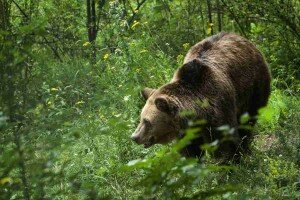BEAR PARK BELITSA
Working hours:
Guided tours every hour
April – September: 10 a.m. – 6 p.m.
October – November: 10 a.m. – 4 p.m.
December – March: 10 a.m. – 4 p.m. (no guided tours)
Bear Park Sanctuary Belitsa
Andrianov Chark area, town of Belitsa, district of Blagoevgrad, BULGARIA
Phone:
E-mail:
Donations: http://www.vier-pfoten.bg/en/support-us/
The Bear Park near the town of Belitsa is an ongoing success story. With more than 20 former dancing bears the compound is divided into seven enclosures which enable the expert staff to separate them into friendly groups and thus keep territorial problems raised by such a dense population at bay and stimulate their individual recovery. Almost all bears are hibernating in the winters – something they could not do in their lives as dancing bears, and which is an exceptionally good sign for their progress.
History of the Dancing Bears Park
In the late 1990s tourists had become aware of the existence of dancing bears on the Black Sea coast and big cities of Bulgaria and called the attention of FOUR PAWS to the situation. A small research unit was sent to the region and returned with results that bears were still being used as tourist attractions, the legal situation did not offer much room for intervention, and the Roma families involved in the business appeared keen on maintaining their tradition.
Further endeavours did however break the ice and offered initial possibilities to take measures against the gruesome practice. When it was clear that a lasting solution for the bears should be realised on Bulgarian soil, a suitable habitat for the animals was found near the town of Belitsa, a vast mountain region that offered secluded spots. Due to the high costs of building a maintainable refuge in accordance with the highest standards, FOUR PAWS needed a strong, long-term partner. The Brigitte Bardot Foundation agreed to co-fund the project and has been a reliable associate ever since.
The first set-up of the project contained three sectors with an area of 11 000 sq. m. and an information and mainenance building. Meanwhile, talks with the families keeping bears resulted in transfer options that seemed workable for all parties involved. In 2000 the first three bears were rescued: Kalina, Mariana and Stefan. Soon more bears were to follow them. It became clear that the initial layout of the park had to be rapidly widened and in 2004 twelve additional hectares and a big info centre with a medical room were added to the sanctuary.
What had seemed like a faraway goal in the year 2000 became a fact in 2007, as Mima, Svetla and Misho – the last three dancing bears of Bulgaria and the EU – were transferred to the Dancing Bears Park. Two years later tha last three dancing bears from the Republic of Serbia were also accommodated at the park. Incredible progress occurred between the start of the project and the present day: it is now illegal to keep dancing bears in Bulgaria, the Dancing Bears Park has grown to ten times its original size and harbours all of the remaining former dancing bears in Bulgaria as well as two Serbian bears. A state-of-the-art medical centre and a dedicated staff have turned the FOUR PAWS sanctuary into a milestone of modern animal welfare.

Bulgaria, Belitsa | 2 | Release of female bear Gabriela at the Dancing Bears Park | Female bear Gabriela was rescued by FOUR PAWS from the zoo of Plovdiv, Bulgaria. She was born in 1996 and was a fromer circus bear, who was too hard to train and as consequence in 2000 was donated to the zoo of Plovdiv. Since then she has been living in an enclosure of merely 15 sq. m. Several months after she was accommodated in the zoo, she was injured by another bear and lost one of her front legs. FOUR PAWS took Gabriela together with male bear Nasko (b. 1988) and accommodated them at the Dancing Bears Park for 1.5 years, while their enclosure at the zoo was being repaired and expanded. Here: after living all her life in a concrete cage, Gabrilea is released in an open enclosure at the Dancing Bears Park and makes her first steps under open air and on grass.
The concept
One of the main cornerstones of the sanctuary is: no breeding. It would not only be hazardous for the bears, who are often too old and medically fragile to give birth without complications, but would also doom the cubs to spend all their life in captivity, as cubs born to animals in captivity could never learn to live independently in the wilderness. A sanctuary is not a zoo.
A return to natural instincts is encouraged on all levels. The feeding procedures mimic the daily lives of animals in the wild: the professional staff is dispersing the food throughout the enclosures, so the bears essentially need to spend a substantial amount of their time to find the food. Almost all dancing bears rescued by FOUR PAWS have sooner or later started to hibernate in the winter – many of them have dug their own dens. A major achievement in the recovery process of these deprived animals!


